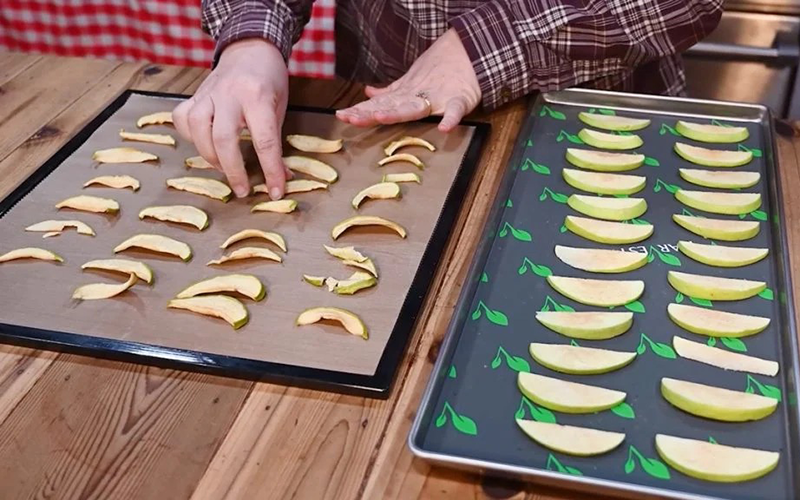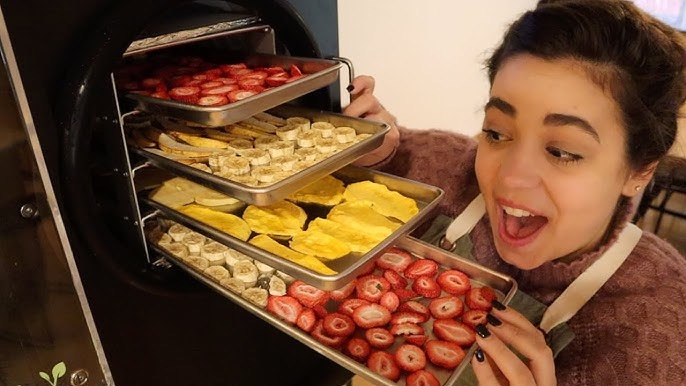
Content Menu
● Understanding Food Dehydration
>> What is Food Dehydration?
>> How Does a Dehydrator Work?
● Benefits of Using a Food Dehydrator
● Understanding Freeze-Drying
>> What is Freeze-Drying?
>> How Does Freeze-Drying Work?
● Benefits of Freeze-Drying
● Can You Freeze Dry Food in a Dehydrator?
● Key Differences Between Freeze-Drying and Dehydrating
● Why You Cannot Freeze Dry with a Dehydrator
● Alternatives for Freeze-Drying
● Tips for Using a Food Dehydrator
● Creative Uses for Dehydrated Foods
● Conclusion
● FAQ
>> 1. What types of foods can be dehydrated?
>> 2. How long does it take to dehydrate food?
>> 3. Can I rehydrate dehydrated foods?
>> 4. Is it safe to dehydrate meat?
>> 5. How should I store my dehydrated foods?
● Citations:
Food preservation is a topic of great interest, especially for those who want to extend the shelf life of their favorite foods. One method that has gained popularity is freeze-drying. However, many people wonder if they can achieve similar results using a food dehydrator. This article will explore the differences between freeze-drying and dehydrating, the capabilities of food dehydrators, and whether you can freeze-dry food in a dehydrator.

Understanding Food Dehydration
What is Food Dehydration?
Food dehydration is a process that removes moisture from food, inhibiting the growth of bacteria, yeast, and mold. This method preserves the food while maintaining its nutritional value. Dehydrators use low heat and airflow to evaporate moisture from food items.
How Does a Dehydrator Work?
A food dehydrator operates by circulating warm air around the food placed on its trays. The heat typically ranges from 95°F to 165°F (35°C to 74°C), depending on the type of food being dried. This gradual heating process allows moisture to escape without cooking the food, preserving its flavor and nutrients.
Benefits of Using a Food Dehydrator
- Nutritional Preservation: Dehydrating retains most vitamins and minerals.
- Cost-Effective: It allows you to buy fruits and vegetables in bulk when they are in season and preserve them for later use.
- Convenience: Dehydrated foods are lightweight and easy to store.
- Versatility: You can dehydrate a wide variety of foods, including fruits, vegetables, meats, and herbs.
- Extended Shelf Life for Food: By removing moisture, the dehydrator inhibits bacterial growth and spoilage, allowing you to store your favorite fruits, vegetables, and snacks for months[1].
- Healthy Snack Options: Dehydrated snacks are a healthier alternative compared to those laden with preservatives and additives. You can make your own dried fruit, vegetable chips, or jerky[1].
Understanding Freeze-Drying
What is Freeze-Drying?
Freeze-drying is a more complex process that involves freezing the food first and then reducing the surrounding pressure to allow the frozen water in the food to sublimate directly from ice to vapor. This method preserves not only the structure but also the flavor and nutritional content of the food.
How Does Freeze-Drying Work?
1. Freezing: The food is rapidly frozen at very low temperatures.
2. Vacuum: The frozen food is placed in a vacuum chamber where air pressure is reduced.
3. Sublimation: Heat is applied gently, causing ice to turn into vapor without passing through a liquid phase.
This meticulous process results in lightweight, shelf-stable food that retains its original shape and flavor.

Benefits of Freeze-Drying
- Long Shelf Life: Freeze-dried foods can last up to 25 years or more when stored properly.
- Retained Nutrients: This method preserves more nutrients compared to traditional drying methods.
- Rehydration: Freeze-dried foods rehydrate quickly and maintain their original texture and taste.
Can You Freeze Dry Food in a Dehydrator?
The short answer is no; you cannot freeze-dry food in a dehydrator. While both methods aim to preserve food by removing moisture, they operate on different principles and achieve different results.
Key Differences Between Freeze-Drying and Dehydrating
| Feature | Freeze-Drying | Dehydrating |
| Process | Freezing followed by sublimation | Heating with airflow |
| Equipment | Freeze-dryer | Food dehydrator |
| Moisture Removal | Sublimation | Evaporation |
| Shelf Life | Up to 25 years | 1-2 years |
| Nutritional Retention | Higher retention | Good retention |
| Texture After Rehydration | Similar to fresh | Chewy or leathery |
Why You Cannot Freeze Dry with a Dehydrator
- Temperature Control: A dehydrator cannot reach the low temperatures required for freezing food effectively before drying it.
- Pressure Reduction: Dehydrators do not create a vacuum environment necessary for sublimation.
- Moisture Removal Method: The dehydration process relies on evaporation rather than sublimation, which affects texture and taste.
Alternatives for Freeze-Drying
If you're looking for alternatives to freeze-drying but want similar results, consider these options:
- Commercial Freeze-Dryers: Investing in a home freeze-dryer can be expensive but provides excellent results for long-term storage.
- Oven Drying: While not as effective as freeze-drying, using an oven at low temperatures can help dry certain foods.
- Air Drying: For herbs or thinly sliced fruits, air drying can be an effective method if you live in a dry climate.
Tips for Using a Food Dehydrator
To maximize your dehydrating efforts, consider these tips:
1. Pre-Treat Fruits: Soak fruits in lemon juice or ascorbic acid solutions before dehydrating to prevent browning.
2. Cut Uniformly: Ensure that all pieces are cut uniformly for even drying[5].
3. Monitor Temperature: Use a thermometer to ensure your dehydrator maintains consistent temperatures throughout the process[2].
4. Store Properly: Store dehydrated foods in airtight containers away from light and moisture for optimal shelf life[9].
5. Experiment with Recipes: Try different recipes using your dehydrated ingredients—soups, snacks, or trail mixes!
6. Check Often: While dehydrators run for several hours without supervision, it's wise to check periodically to ensure even drying[10].
7. Conditioning Dried Foods: After drying, allow foods to cool before storing them in airtight containers; this helps equalize moisture levels among pieces[8].
8. Avoid Overcrowding Trays: Ensure there's enough space between pieces on trays for proper airflow; overcrowding can lead to uneven drying[5].
9. Use Proper Storage Techniques: Consider vacuum sealing your dried foods if you want them to last longer[9].
10. Explore Different Ingredients: Almost anything can be dehydrated! From fruits like apples and bananas to vegetables like zucchini or carrots—experiment with what you have on hand[9].
Creative Uses for Dehydrated Foods
Dehydrated foods are not just snacks; they can be incorporated into various dishes:
- Soups & Stews: Add dried vegetables directly into soups or stews during cooking—this saves time while enhancing flavor.
- Trail Mixes: Combine dried fruits with nuts and seeds for nutritious trail mixes perfect for hiking or snacking.
- Smoothies: Blend dried fruits into smoothies for added sweetness without excess sugar.
- Baking Ingredients: Use dried fruits or herbs as ingredients in baked goods like muffins or bread.
- Camping Meals: Pack lightweight dehydrated meals for camping trips—just add water!
Conclusion
In conclusion, while both freeze-drying and dehydrating are effective methods for preserving food, they are fundamentally different processes that yield different results. A dehydrator cannot replicate the freeze-drying process due to its inability to freeze food or create a vacuum environment necessary for sublimation.
If you are interested in long-term storage of foods with retained flavor and nutrients, investing in a commercial freeze-dryer may be worthwhile. However, if you are looking for a cost-effective way to preserve seasonal produce or create snacks, using a food dehydrator remains an excellent choice.

FAQ
1. What types of foods can be dehydrated?
You can dehydrate fruits, vegetables, meats (like jerky), herbs, and even some dairy products like yogurt.
2. How long does it take to dehydrate food?
Dehydration times vary based on the type of food and thickness but generally range from 4 hours (for herbs) to 24 hours (for meats).
3. Can I rehydrate dehydrated foods?
Yes! Most dehydrated foods can be rehydrated by soaking them in water or adding them directly into soups or stews while cooking.
4. Is it safe to dehydrate meat?
Yes! When making jerky or other meat products, ensure proper temperature control during dehydration (at least 160°F/71°C) to kill any potential bacteria.
5. How should I store my dehydrated foods?
Store them in airtight containers away from light and moisture—vacuum sealing is ideal for long-term storage.
Citations:
[1] https://etsolutions.in/10-amazing-benefits-of-electrical-food-dehydrator-machines/
[2] https://cosori.com/blogs/blog/how-does-a-food-dehydrator-work
[3] https://homesteadingfamily.com/preservation-101-intro-to-dehydrating-food/
[4] https://www.webstaurantstore.com/guide/741/food-dehydrators-buying-guide.html
[5] https://vacuumsealersunlimited.com/how-to-use-a-food-dehydrator/
[6] https://www.commercialdehydrators.com.au/dehydrating-recipes-filters
[7] https://www.bestbuy.com/discover-learn/10-reasons-to-buy-a-food-dehydrator/pcmcat1634332391134
[8] https://www.youtube.com/watch?v=lEUA2t2XD5M
[9] https://www.webmd.com/diet/dehydrating-food-good-for-you
[10] https://www.osbheatpump.com/news/how-to-use-a-food-dehydrator-10-useful-tips-for-beginners-and-advanced-users/











